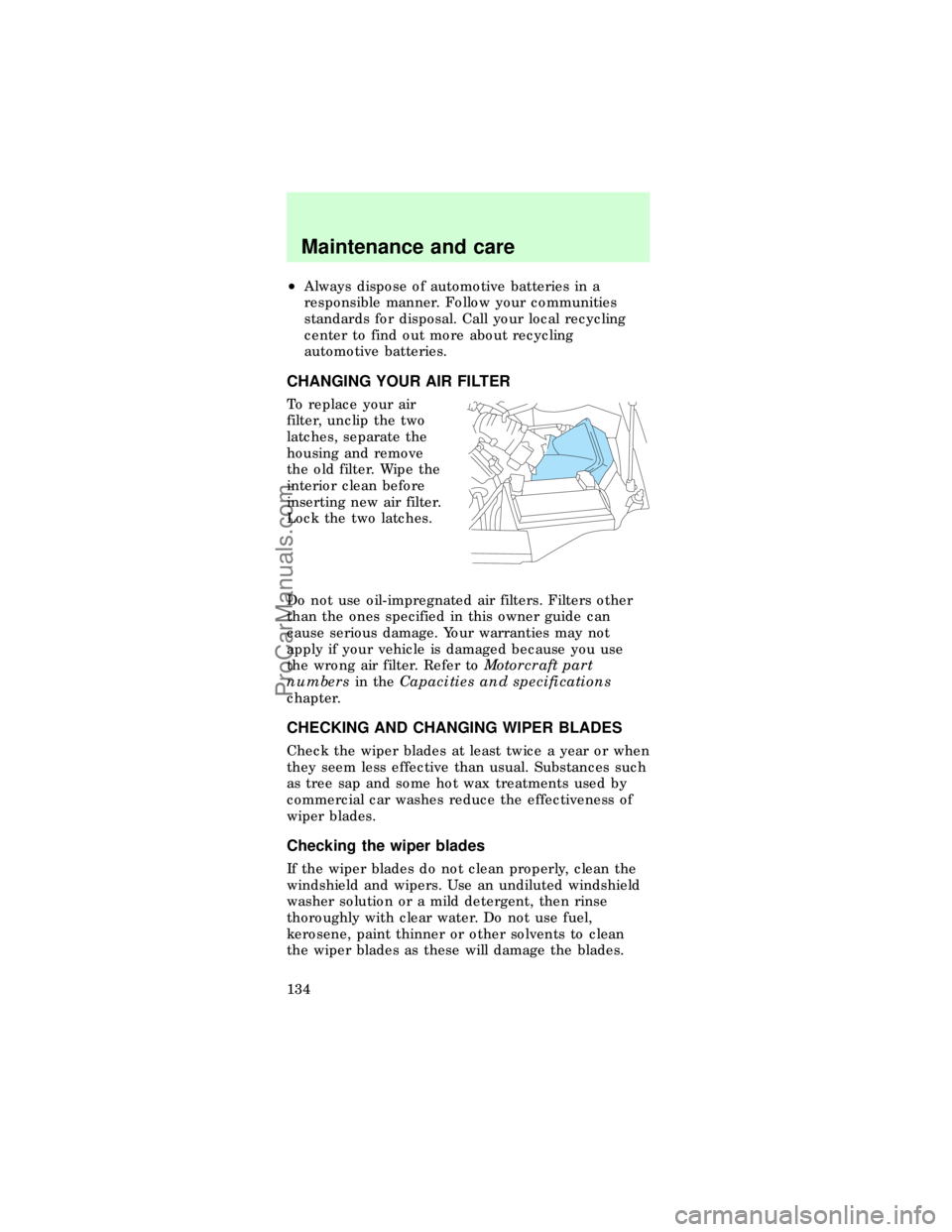Page 8 of 167

Cruise control (if equipped)
This light comes on
when the cruise control
ON button is pressed.
It turns off when the
cruise control OFF
button is pressed or when the ignition is turned to
the OFF position.
Brake system warning
Extinguishes when the
parking brake is
released. Illumination
after releasing the
parking brake indicates low brake fluid level.
Engine oil pressure
When the oil pressure
is below the normal
operating range, this
lamp will illuminate.
The engine oil level being too high or too low could
cause this lamp to illuminate. This lamp will come
on when the ignition is first turned on but then
should turn off. If the lamp stays on, continued
operation will cause severe engine damage.
Charging system
Briefly illuminates
when the ignition is
turned on and the
engine is off. The light
also illuminates when the battery is not charging
properly, requiring electrical system service.
Air bag readiness
Briefly illuminates
when the ignition is
turned on and the
engine is off. If the
CRUISE
P!
BRAKE
Instrumentation
9
ProCarManuals.com
Page 101 of 167
Fuse/Relay
LocationFuse Amp
RatingDescription
3 10A Left low beam
headlamp
4 10A Right low beam
headlamp
5 5A Brake shift
interlock , rear
defroster
6 15A MLPS switch,
backup lamps,
speed control,
climate control
7 10A MLPS switch,
starter relay
8 5A Power antenna,
radio control
unit, GEM
9 10A Anti-lock
brakes system,
Central
Temperature
Monitor
10 20A EEEC relay,
ignition coil,
passive
anti-theft
system, radio
11 5A Air bag
indicator,
instrument
cluster
Roadside emergencies
102
ProCarManuals.com
Page 120 of 167
1. Automatic transaxle fluid dipstick
2. Brake fluid reservoir
3. Air filter assembly
4. Battery
5. Engine oil filler cap
6. Engine oil dipstick
7. Power steering fluid reservoir
8. Engine coolant reservoir
9. Windshield washer fluid reservoir
3.0L Duratec engine
1. Automatic transaxle fluid dipstick
2. Brake fluid reservoir
3. Air filter assembly
4. Battery
5. Engine oil filler cap
6. Engine oil dipstick
7. Engine coolant reservoir
8912
3
4
56
7
Maintenance and care
121
ProCarManuals.com
Page 121 of 167
8. Windshield washer fluid reservoir
9. Power steering fluid reservoir
3.4L SHO engine
1. Automatic transaxle fluid dipstick
2. Brake fluid reservoir
3. Air filter assembly
4. Battery
5. Engine oil dipstick
6. Engine oil filler cap
7. Engine coolant reservoir
8. Windshield washer fluid reservoir
9. Power steering fluid reservoir
8
9123
456
7
Maintenance and care
122
ProCarManuals.com
Page 122 of 167

CHECKING AND ADDING ENGINE OIL
Checking the engine oil
Check the engine oil each time you fuel your
vehicle.
To check the oil:
1. Make sure the vehicle is on level ground. If the
engine is warm, turn the engine off and wait a few
minutes for the oil to drain into the oil pan.
2. Set the parking brake and ensure the gearshift is
securely latched in P (Park).
3. Open the hood. Protect yourself from engine heat.
4. Locate and carefully
remove the engine oil
dipstick.
5. Wipe the dipstick clean. Insert the dipstick fully,
then remove it again. The oil level should be in the
range shown on the dipstick.
6. If the oil level is below the MIN line or the ADD 1
QUART line, add oil as necessary. If the oil level is
beyond the MAX or FULL line, engine damage or
high engine oil consumption may occur and some oil
must be removed from the engine by a service
technician.
7. Put the dipstick back in and ensure it is fully
seated.
Adding engine oil
1. Check the engine oil. For instructions, refer to
Checking the engine oilin this chapter.
2. If the fluid level is not within the normal range,
add only certified engine oil of the preferred
viscosity. Add engine oil through the oil filler cap.
ADD 1 QTFULL
Maintenance and care
123
ProCarManuals.com
Page 123 of 167

Remove the filler cap and use a funnel to pour oil in
the opening.
3. Recheck the oil level. Make sure the oil level is
not above the MAX or FULL mark on the dipstick.
ENGINE OIL RECOMMENDATIONS
Use SAE 5W-30 motor
oil meeting Ford
specification
WSS-M2C153±F or
equivalent. Only use oil
certified for gasoline
engines by the
American Petroleum
Institute.
Do not use supplemental engine oil additives, oil
treatments or engine treatments. They are
unnecessary and could, under certain conditions,
lead to engine damage which is not covered by your
warranty.
CHANGING THE ENGINE OIL AND FILTER
Change your engine oil and filter according to the
following mileage and time requirements, whichever
occurs first:
²Normal Schedule ± 8,000 km (5,000 miles) or six
months.
²Severe Duty Schedule - 5,000 km (3,000 miles) or
three months. Severe duty operation would
include extensive idling, trailer towing, driving in
severe dust and police, taxi or delivery service.
Ford production and aftermarket (Motorcraft) oil
filters are designed for added engine protection and
long life. If a replacement oil filter is used that does
not meet Ford material and design specifications,
startup engine noises or knock may be experienced.
It is recommended you use the appropriate
Motorcraft oil filter (or another brand meeting Ford
specifications) for your engine application.
Maintenance and care
124
ProCarManuals.com
Page 133 of 167

²Always dispose of automotive batteries in a
responsible manner. Follow your communities
standards for disposal. Call your local recycling
center to find out more about recycling
automotive batteries.
CHANGING YOUR AIR FILTER
To replace your air
filter, unclip the two
latches, separate the
housing and remove
the old filter. Wipe the
interior clean before
inserting new air filter.
Lock the two latches.
Do not use oil-impregnated air filters. Filters other
than the ones specified in this owner guide can
cause serious damage. Your warranties may not
apply if your vehicle is damaged because you use
the wrong air filter. Refer toMotorcraft part
numbersin theCapacities and specifications
chapter.
CHECKING AND CHANGING WIPER BLADES
Check the wiper blades at least twice a year or when
they seem less effective than usual. Substances such
as tree sap and some hot wax treatments used by
commercial car washes reduce the effectiveness of
wiper blades.
Checking the wiper blades
If the wiper blades do not clean properly, clean the
windshield and wipers. Use an undiluted windshield
washer solution or a mild detergent, then rinse
thoroughly with clear water. Do not use fuel,
kerosene, paint thinner or other solvents to clean
the wiper blades as these will damage the blades.
Maintenance and care
134
ProCarManuals.com
Page 142 of 167

The Scheduled Maintenance Services listed in the
Service Guideare required because they are
considered essential to the life and performance of
your vehicle and to its emissions system.
Ford strongly recommends the use of genuine Ford
replacement parts. If other than Ford or Motorcraft
parts or Ford authorized parts are used for
maintenance replacements or for the service of
components affecting emission control, such
non-Ford parts should be equivalent to genuine Ford
Motor Company parts in performance and durability.
It is the owner's responsibility to determine the
equivalency of such parts. Please consult your
Warranty Information Booklet for complete warranty
information.
Do not park, idle, or drive your vehicle in
dry grass or other dry ground cover. The
emission system heats up the engine compartment
and exhaust system, which can start a fire.
Watch for fluid leaks, strange odors, smoke, loss of
oil pressure, the charging system warning light, the
service engine soon light or the temperature warning
light. These sometimes indicate that the emissions
system is not working properly.
Do not make any unauthorized changes to your
vehicle or engine. Changes that cause more
unburned fuel to reach the exhaust system can
increase the temperature of the engine or exhaust
system.
By law, anyone who manufactures, repairs, services,
sells, leases, trades vehicles, or supervises a fleet of
vehicles is not permitted to intentionally remove an
emission control device or prevent it from working.
In some of the United States and Canada, vehicle
owners may be liable if their emission control device
is removed or prevented from working.
Maintenance and care
143
ProCarManuals.com